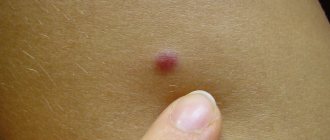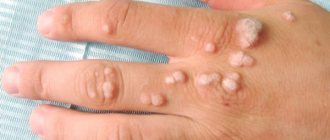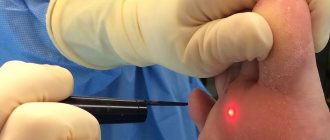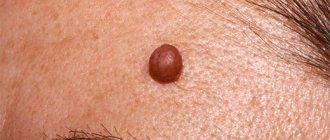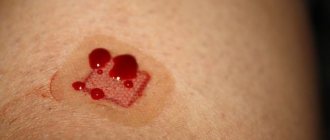How does the healing process work?
- 3-4 hours after removal of the mole, the wound is covered with a dark dense crust. And after a few hours, the area around it swells and turns red. This is an absolutely normal reaction of the body. The entire healing process lasts from 14 days to a month.
- First week. The scab that appears at the site of the birthmark is prohibited from being torn off. It has a protective function: to protect the wound from infection and allow new tissue to grow. The wound is protected from mechanical damage, friction with clothing, a bath sponge, and scratching. You should also not use cosmetic creams.
Frequently asked question: can a scar or scar appear at the site of a removed mole? Such a nuisance can happen if the protective scab is torn off from the wound surface. Therefore, doctors strongly recommend protecting the wound from outside interference.
- Second week. After about 7-10 days, the dry crust disappears on its own. Instead, a pale pink skin remains. It should not be exposed to sunlight. If the mole was on the face, then use sunscreen with SPF 50. Otherwise, unwanted pigmentation may occur.
- The next two weeks. Usually, by day 20, the site of the removed mole is overgrown with full healthy skin. A slight itching may occur at the wound site, but special skin care is no longer required after getting rid of the birthmark. A month after the operation, the scar from the birthmark will smooth out, and after 2 months only an inconspicuous microscar will remain.
How to get rid of moles
If moles begin to bother you and cause discomfort, and the doctor says that they need to be removed, then they need to be removed as quickly as possible. The most important thing you shouldn’t do is try to get rid of a mole, and especially a troublesome mole, on your own in “makeshift” conditions. Independent “operations” are strictly prohibited, as they can cause complications: blood poisoning or large blood loss, because there is a chance that you simply will not be able to stop the flow of blood if you disturb or damage the mole.
Pharmacies sell celandine-based preparations designed to remove warts. Some believe that they can safely remove moles. However, this is a big misconception. Firstly, these tinctures can seriously burn the skin around the mole, leaving extensive scars, and secondly, they can disrupt the very structure of the mole, which can lead to the rapid development of skin cancer. It is also not recommended to carry out the procedure for removing moles in beauty parlors and beauty salons, unless they have certified and qualified dermatologists and oncologists.
There are several methods for removing moles (surgical, electrocoagulation, cryodestruction, laser evaporation. The choice of method for removing moles is usually based on the characteristics and condition of a particular mole, as well as the degree of possible threat to the body. If we take the general case of non-troublesome moles, according to According to many experts, the most effective in all respects is the laser method of mole removal.
The laser removal procedure looks like this: local anesthesia is applied to the treatment area, and then, using modern lasers, the surface of the mole is gradually processed, evaporating its layers one by one. The high accuracy of such operations is ensured by the latest laser technologies - you can control the depth of exposure and set the required beam diameter. Why is this method so popular among doctors? Its first and main advantage is the complete absence of any even the slightest bleeding, the complete elimination of the possibility of contamination of the treated surface with various microbes and infections , since laser treatment is a non-contact procedure. Well, important factors are the aesthetic side and the time spent on the removal process itself, as well as the recovery period of the treated area of skin. The laser “operation” itself lasts less than 5 minutes, and the recovery period of the skin in the treatment area does not exceed 2-3 weeks. Moreover, after complete healing and regeneration of the skin, practically no traces remain at the site of the former mole.
How to care for a wound after mole removal
Sometimes the doctor prescribes treating the scab with disinfectants or ointment with an antimicrobial effect. The most popular care products after mole removal include:
- weak solution of potassium permanganate. It dries out the crust and has an antiseptic effect;
- alcohol solution of brilliant green, or brilliant green. Also a good antiseptic.
Otherwise, routine wound care after mole removal boils down to monitoring the damaged area. Signs of an incorrect healing process will be:
- purulent discharge;
- severe itching, wetness;
- prolonged bleeding;
- increased body temperature;
- noticeable swelling of the skin for several days.
If you notice these symptoms, contact your doctor.
How are moles removed?
There are several removal methods, and they all have their own indications and contraindications. The classic method is the surgical use of a scalpel. This excision is quite rough in terms of scarring, especially on the face, but it is ideal for moles that are deeply embedded in the skin. The same method is best suited for cancer nevi on open areas of the body. Sutures on the face are removed on days 4-7, and on the body on days 8-20 after the removal procedure.
Another popular method is electrocoagulation. It is carried out for 15-30 minutes and consists of burning out a mole or papilloma with an electrode. There are almost no traces after this, the procedure is considered non-traumatic. Scars after it are rare.
Cryodestruction is the removal of moles by freezing with liquid nitrogen. According to statistics, wounds always heal much faster after this method.
Removal with a radio knife - this low-traumatic procedure is second only to laser. Leaves virtually no traces.
Laser is a highly sought-after method for its safety and speed, as well as its effectiveness. The laser, in addition, clogs the blood vessels, preventing bleeding and relapses. It is not used only for oncology.
What restrictions exist after the procedure?
- In the first three to five days after the procedure, alcohol is excluded from the diet. Alcoholic drinks dilate blood vessels, increasing the likelihood of bleeding.
- For two weeks after laser removal of a birthmark, you should avoid contact with water. It is recommended not to visit the bathhouse, sauna, or swimming pool.
- You will have to protect your skin from sunlight and solarium lamps for a whole month. This will save you from possible hyperpigmentation.
If you follow simple wound care rules after mole removal, recovery will be quick and painless.
Answers to questions - Moles, warts, papillomas, stretch marks, scars, CO2 laser
Answered by Irina Vyacheslavovna Markova, a cosmetologist-surgeon for 11 years - The total cost of removal consists of several components, the price of which is indicated in the price list: 1. Consultation with a cosmetologist-surgeon, which is carried out before the procedure. At the time of writing this text, the consultation price is 900 rubles, this amount is paid before the consultation. 2. The actual cost of tumor removal, which depends on the type of tumor (moles, warts, papillomas), the total number of tumors removed, the size in millimeters of each tumor and location (face, body, plantar wart). Please note that the price is set per 1 mm diameter. In this case, the largest diameter is taken into account in the case of a neoplasm of irregular shape. In addition, high-quality removal of a tumor involves careful treatment of the surface of contact between healthy skin tissue and the cells of the tumor being removed. Therefore, the apparent size must be increased by at least 1 mm. In case of removal of a tumor on the day of the consultation, two options are possible: 1) in case of a minor tumor, the cost of removal of which does not exceed the consultation fee, the removal is carried out free of charge; 2) otherwise, the price for removing tumors is reduced by the cost of the consultation, thus, the cost of the consultation is fully included in the removal and the consultation is virtually free. 3. Cost of anesthesia: depending on the circumstances, infiltration anesthesia (injection) or application anesthesia (applied to the surface) can be used. 4. After removal, if oncology is suspected, a histological examination of the removed tissue may be required, which is paid for separately. 5. When removing a large tumor, for example, a wart on the sole with a diameter of 10 mm, sutures and bandaging may be required. Let's consider the cost of removing a mole on the body with a diameter of 4 mm in prices valid at the time of writing this text: 1) consultation - 900 rubles 2) laser removal of a benign formation (nevi, moles, etc.), for 1 mm of diameter (body) - 400 rubles ; the cost of removing a tumor with a diameter of 4 mm will be 1,600 rubles; Taking into account the consultation fee, the cost of removal will be 700 rubles. 3) infiltration anesthesia, 1 ampoule - 300 rubles. Thus, without histology, the total cost will be 1900 rubles. The cost of histological examination is 2900 rubles and is paid separately.
How does laser mole removal work?
The procedure for removing moles is standard and includes several stages:
- Examination of the skin by a dermatologist to exclude the presence of signs of melanoma. There is a classification of 5 criteria for which the doctor must examine and check the formation. Shape, size, color, surrounding tissue, density. Sometimes dermatoscopy (examination of an element under multiple magnification) can be used for diagnosis. Having completely convinced that the formation is benign, the specialist begins the removal procedure itself.
- Consultation before the procedure. The dermatologist talks about how the procedure will take place and the symptoms that will accompany it. Possible complications and limitations that will occur after the manipulation.
- Signing the patient's informed consent for the administration of anesthetic and laser vaporization.
- Next, he proceeds directly to removing the mole. The area is treated with a skin antiseptic. An anesthetic injection is given. After complete freezing, the mole is removed within healthy tissue using a CO laser. Repeated treatment with a disinfecting solution is carried out.
- Recommendations for care.
What can inflammation lead to?
Purulent discharge always indicates the development of a bacterial or fungal infection. They are dead cells that the body wants to get rid of. The accumulation of pus under a mole can be provoked by:
- its damage and further infection of the wound,
- any skin infection that has spread to a pigmented area.
Suppuration of a nevus is very dangerous, as it can increase the risk of malignancy of its cells. Inflammation of the skin in this area can also be a symptom of melanoma that has already begun to develop. Only an experienced dermatologist can determine what exactly triggered the inflammatory process.
How long will it take to heal?
When a mole is removed using the laser method, in addition to a scar, a small burn remains on the skin. The healing process will take longer.
In other options, the nevus heals faster. After a few days, a dry crust forms, which performs a protective function and cannot be injured or torn off. When the crust itself comes away from the skin, a light spot will remain.
The most problematic areas for healing are the armpits, folds of the skin, and parts of the body covered with hair (including the groin). It is necessary to handle with greater frequency and, if possible, leave it open to avoid damage.
The duration of healing depends on the size and depth of the nevus legs. The maximum healing period is from 7 to 20 days. A small pigment spot may disappear within 3 days.
Care for 10-14 days after the procedure
A mole has been removed - how to treat it, and how does the wound heal? Most often, 2 weeks after excision, the existing crust disappears, and in its place a new thin pink skin remains. Then you should definitely use a wound-healing ointment: “Actovegin”, “Rescuer” cream or “Levomekol”. They are used for 10-14 days.
By the end of 3 weeks everything is usually healed and treatment is stopped. But with increased sensitivity, itching may persist, and the doctor may prescribe special creams with an antipruritic effect: Sinaflan, Beloderm and their analogues. They often relieve itching immediately, from the first use.
Reparative processes are accelerated with the help of vitamin-mineral complexes, creams with hyaluronic acid, and the use of peelings.
How to avoid scars?
All modern methods of mole excision are initially aimed at preventing the formation of scars. But sometimes this cannot be avoided.
Scars appear as a result of the growth of new skin cells at the site of damage. Therefore, for preventive purposes, doctors often recommend the Contractubex gel, which was already mentioned above. It contains onion extract, which inhibits fibroblasts, which provoke the growth of scar tissue. Heparin in the drug prevents the formation of blood clots, softens the scar and restores the skin. Allantoin has a keratolytic effect and increases skin permeability. Serae onion extract has fibrinolytic and anti-inflammatory properties, controls the number of fibroblasts. “Kontratubeks” removes scars completely within a month if they are fresh. Rub it in 2-3 times a day.
Don't forget about other restrictions:
- do not scratch the healing site;
- Do not allow dry skin;
- It's better to quit smoking.
If these points are not observed, the scars will be large, and small ones, resembling a thin cobweb, will be a natural consequence. Scars in the place where a mole was removed are easily masked with decorative cosmetics. What to process? Limitations on means and actions:
- It is prohibited to sunbathe, visit solariums and beaches, and go to the sauna and bathhouse. Open areas should be covered with clothing, the head with a hat or umbrella, and sunscreen should be used for the face and neck.
- Do not touch the injury unnecessarily to prevent infection.
- Do not expose the painful area to injury. This will make the condition worse. Repeat surgery may be required.
- Do not peel off the resulting crust. This slows healing and promotes scarring.
- After surgery, the injured area should not be exposed to scrubs or decorative cosmetics.
- For the first 14 days after surgery, until epithelization occurs, the affected area should not be wetted. In case of urgent need, bathing is in principle possible, but only if there is a plaster on the site of the operation.
- Do not expose the wound to friction with hard towels or clothing. Things should be thin, light and free. Children love to scratch their wounds - this requires supervision. Also, the skin must be protected from temperature changes - the condition of the wound may worsen.
Bandage or patch
A mole has been removed - how to treat the wound? In addition to antiseptic solutions, the main attributes are plasters and bandages. Today, instead of the usual bandages and adhesive plaster, special devices are used that not only protect the wound, but also promote rapid healing.
If a mole has been removed, what should I use to treat it? Care may be as follows - Mepiform silicone patch - created specifically for the resorption of hypertrophic and keloid scars. Available in different shapes and sizes. The treatment period for such scars is long, up to 8 months.
Skin care after removal
During the first week, the wound is covered with a dark crust, which generally serves as a protection, and which in no case should be forcibly removed. It covers the damaged area until new skin grows. Also, you should not get it wet, smear it with creams, cosmetic masks, etc.
So, you’ve removed a mole – what should you use to treat it? On the first day, it is very good to treat the damaged area of skin with potassium permanganate - the effect is disinfecting and drying. During the processing process itself, it is necessary to maintain sterility. This means using disposable supplies. Hands must be worn with disposable medical gloves; if they are not available, hands must be treated with alcohol or Chlorhexidine.

